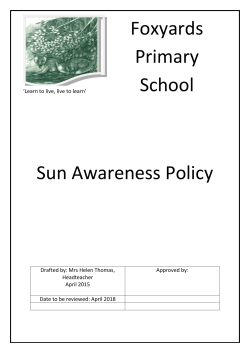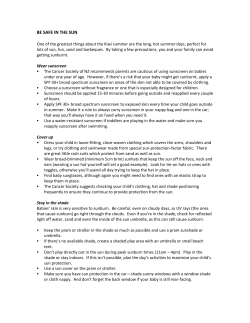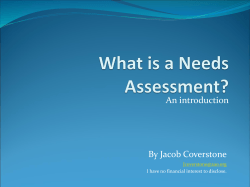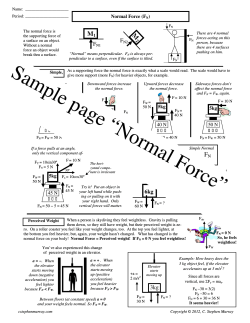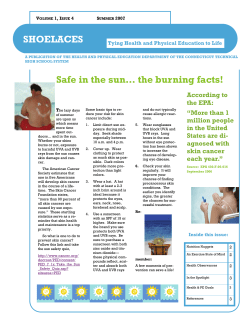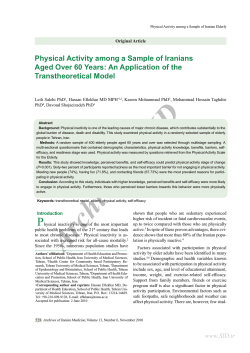
Perceived Skin Cancer Risk among a Community-Based Sample of Black Adults
Perceived Skin Cancer Risk among a Community-Based Sample of Black Adults Latrice C. Pichon, PhD, MPH, Irma Corral, PhD, MPH, Hope Landrine, PhD, Joni A. Mayer, PhD, Denise Adams-Simms, MPH 31st Annual Meeting of the Society of Behavioral Medicine Seattle, Washington Health Behavior Theory • Construct: perceived risk • Def: ↑ perceived risk, ↑ health protective behaviors I think I am at risk for disease X Thus, I will do Y to prevent X Perceived Skin Cancer Risk • White Adults – 13% to 25% Perceived High Risk – ↑Incidence MM and NMSC – ↑Sun Exposure • Predictors – Family or Personal History – Sun Sensitive Skin – Gender – Sunscreen Use Role of Perceived Skin Cancer Risk in Sun Protection Behaviors • Whites – Family History of MM • ↑ risk and ↑ sun protection (+) – College Students • ↑ risk and ↓ sun protection (-) • Blacks – ↓ perceived skin cancer risk – ↓ sun protection behaviors – Unknown/untested relationship Study Purpose • Explore the relationship between perceived skin cancer risk and sun protection behaviors among self-identified Blacks • A relationship is unknown for Blacks Research Questions • Was perceived skin cancer risk associated with … – – – – Demographic factors? Prior cancer diagnosis? Skin type? Sunscreen use? Academic-Community Partnership • Partners – California Black Health Network (CBHN) – San Diego State University (SDSU) • Participatory Process – External Funding – Selection of Research Questions – Study Design – Recruitment – Measures/Instrument – Dissemination of Findings Sampling Procedures • Stratified, statewide, random sample • 90% of CA Blacks reside in 7 Counties – Northern: San Francisco, Oakland, Sacramento – Southern: San Bernardino, Riverside, Los Angeles, San Diego • Blacks were sampled from cities with probability proportional to their representation – e.g., 42% live in L.A.; hence, 42% of sample came from L.A. Sampling Procedures • Stage 1: – 20 census tracts (CTS) randomly selected • Stage 2: – Block groups within CTS were randomly selected • Stage 3: – All homes were sampled until 100-125 participants had been obtained from each CT ***Refusal Rate ≤3%*** Inglewood, CA; CT 6008.01 Inglewood, CA; CT 6008.01 Survey Procedures • Black Surveyors (CBHN/SDSU) • Eligibility – Door-to-door in teams – Weekends during daylight – Script and Letter • 91-item health survey — 7th grade readability — Anonymous — Options: 1) Self-administered 2) Read to participant – Self-identified Black – ≥18 years – 1 adult/household Skin Cancer Risk Perception1 • On a scale of 0 to 100, what do you think your chances of getting skin cancer are, where 0 is no chance of getting skin cancer, and 100 means you will definitely get it? 1McGregor et al., 2004 Sunscreen Use1 During the summer months, how often do you do the following when you are out in the sun for more than 15 minutes? Never Wear sunscreen with SPF of 15 or higher 1 Sometimes About half the time Often Always 2 3 4 5 1Mayer et al., 2007 Skin Type1 Which of the following best describes your skin’s usual reaction to your first exposure to summer sun, without sunscreen, for one-half hour at midday? – – – – – Type I: Always burn, unable to tan Type II: Usually burn, then can tan if I work at it Type III: Sometimes mild burn, then tan easily Type IV: Rarely burn, tan easily None of the above describes me 1Galindo et al., 2007 Characteristics of Study Participants (N = 1,932) >HS % >$26,000 1On a scale of 0 to 100, what do you think your chances of getting skin cancer are, where 0 is no chance of getting skin cancer, and 100 means you will definitely get it? % (0) (1-25) (26-74) (100) 1 McGregor et al., 2004 1During the summer months, how often do wear sunscreen with an SPF of 15 or higher when you are out in the sun for more than 15 minutes? 70 62.7 60 50 % 40 30 20 10 17.7 6.3 6.7 6.6 Often Always 0 Never Sometimes Half the time 1Mayer et al., 2007 1Which of the following best describes your skin’s usual reaction to your first exposure to summer sun, without sunscreen, for onehalf hour at midday? 70 59.1 60 50 % 40 27.8 30 20 9.5 10 0 1.5 Type I 2.5 Type II High Sun Sensitivity Type III Type IV None Low Sun Sensitivity 1Galindo et al., 2007 Summary • Low perceived skin cancer risk among Black adults • No relation between perceived skin cancer risk and demographic factors • Sun sensitivity and a personal history of cancer contributed to higher perceived risk • Lack of association between perceived skin cancer risk and sun protection behaviors Recommendations for Future Research • Measurement – Behavioral anchor on the perceived skin cancer risk survey item e.g., If you do not engage in sun protection behaviors, what are your chances of getting skin cancer? – Cultural correlates of risk perception and sunscreen use e.g., acculturation, structural-environmental factors • Prevention – Culturally-tailored skin cancer prevention programs – Linking sunscreen use with other types of prevention messages Acknowledgements • California Black Health Network – Uzoma Mmeje, Jo Eure, Gayle Watts, Twila Laster, Diane Ake, and Julie Waters • San Diego State University – Ivory Veley, Chassie Jualo, Jonathan Martinez, Danica Aniciete, Yavette Vaden, Isabel Altarejos, Renata Harpster, Maria Flores, Norval Hickman, Michael Hunt, and Arianna Aldridge – Drs. Gregory Norman, James Sallis, John Elder, Linda Hill, and Lisa Madlensky Any Questions?
© Copyright 2025
